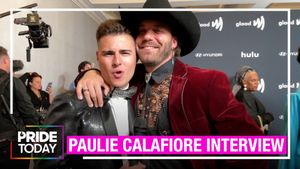
For fans of androgyny, there are few sights as breathtaking as Andrej Pejic, who posed nude, hands artfully placed in the one place that might dispel any illusions, in the June issue of Vogue Brazil. The Serbian-Australian model has become a fashion darling in the last few years, walking the runways in both men's and women's clothing and gracing the covers of numerous magazines, including Out.
Pejic was assigned male at birth and now identifies as genderless, topping a list of other noteworthy up-and-coming transgender models like Lea T, Claudia Charriez, and Isis King. But for all the attention Pejic and Lea T (the muse of Givenchy) are garnering, there's another element to this fashion transformation taking place. Twenty years ago there was a queerification, where gay culture had a significant influence in runway shows and in clothing stores. Today, there's a genderqueering taking place. And it's happening in menswear. Perhaps more to the point, it's happening with menswear.
Saskia de Brauw is another model of the moment, chosen as the face of Yves Saint Laurent's men's spring/summer 2013 collection. She also appeared in Givenchy's men's show in Paris earlier this year, as did lesbian supermodel Jenny Shimizu, who was among the earliest female models to model menswear back in the 1990s.

And bursting on the scene earlier this year was 6-foot-2 former Olympic swimmer-turned-model Casey Legler, the first woman to be signed to Ford Models's men's division. Five months afterward, Legler appeared in the May 2013 issue of
Vogue in an article about the fashion industry's new "gender-flipping" trends, telling the magazine, "I happen to be a woman -- sheer luck of the biological roulette -- who has the great privilege to engage the ways in which gender signifiers can be liberated."
While the mainstream is dipping its tasseled loafers in the androgyny pool, lesbians are leading the way behind the scenes. Project Runway finalist Alicia Hardesty is working on her own tomboy fashion line, and Portlanders Julia Parsley and Emma McIlroy have seen success with Wildfang, their online boutique of curated tomboy clothing (which is aided by a star-studded lesbian fashion video that features The L Word's Katherine Moennig, Gossip drummer Hannah Blilie, and Olympian Megan Rapinoe).
But Tomboy Tailors may be the buzziest of these projects -- the country's first self-described genderqueer menswear shop opened this spring at the upscale Crocker Galleria in San Francisco's Financial District.
"Women have been wearing men's suits for well over 100 years, if not much longer," says Zel Anders, the 48-year-old founder of Tomboy Tailors. "But with changing attitudes about gay marriage, legal changes about gay marriage, and corporate changes in providing more employee benefits for same-sex couples and transgender individuals, it just seems to have gotten a lot easier to wear what you want -- at least in places like San Francisco. My hero, attorney Tanya Neiman, wore her trademark double-breasted suits, bow ties, and wing tips for many years in San Francisco and walked with such elegance and ease. I wanted to have that ease about me and to make it easier for other women to wear the clothes they want to wear."
Anders had been planning Tomboy's launch since 2010, and met with vendors for more than a year before opening the store's doors. She says the store exceeded financial projections in the first month it was open, and she had to hire three new employees in her very first week in business.
 At left: Tomboy Tailors CEO and founder Zel Anders.
At left: Tomboy Tailors CEO and founder Zel Anders.For Anders, a butch fashionista, the love of menswear for women -- what she calls genderqueer clothing -- was a personal one, but it's tapped into a huge market she describes as "butch/boi lesbians, trans-masculine individuals, and women of any identity who have a strong sense of self-expression and like to wear fine, custom-made clothing." Tomboy's bespoke and made-to-order suits have already found fans nationwide, as the clothier has hosted fashion shows (with mostly queer women and trans men as models) and fitting sales on a national tour that's more akin to a rock star's than a fashion designer's.
The reason for the success is simple, says Anders.
"Female-bodied people should have options, just as male-bodied people do, for the fit and quality of their clothing," she argues. "It's very easy for a male-bodied person to walk into a tailor and have that tailor understand their suit sizing and adjustment desires. In contrast, I, as a female-bodied person, have had various experiences with tailors. Sometimes they're confused as to why I would want a suit styled like that of a man, and sometimes they have flat-out attempted to alter the style of my suit to fit their traditional mold of what I should be wearing."
It's a classic lesbian complaint about fashion: many don't want to wear women's styles but don't fit properly in menswear. "We're the first made-to-measure company in America addressing this unique gap in the clothing industry," says Anders. "We're offering an opportunity to look good and feel confident from one experience with us."
Oakland, Calif.-based Mary Going also understands this need. While the Paris runways are about androgyny and mixing up sex and gender markers for aesthetic value, Going, who founded the new lesbian-owned and -operated fashion label Saint Harridan, is filling a longtime need among masculine women like herself.

Going has a lot of fans. The Kickstarter campaign to launch Saint Harridan, which makes ready-to-wear suits and dress shirts for "masculine women of all sizes, shapes, identities" was the seventh-highest-funded fashion Kickstarter ever, raising $137,000 in 30 days.
Enthusiastic supporters pre-purchased 120 suits, 200 dress shirts, and almost 1,000 T-shirts. As soon as the Kickstarter went live, women from around the country began volunteering to model for Saint Harridan, many from areas where lesbians, especially butches, are few and far between. Going planned to bank on that fan excitement with pop-up tours in several key cities, using local women as models, taking orders from the road as Tomboy Tailors does.
The company has been in Going's mind for nearly a decade, beginning in 2004, when she says she and her wife were considering getting married in Massachusetts; she felt she had nothing appropriate to wear. "I thought about it again in 2008 when my state, California, briefly allowed same-sex marriages. That time, we did get married. We'd been together for 10 years. I had a custom suit made for our wedding and I loved how I felt in that suit."
She agrees with Anders that an interest in genderqueer fashion has always been there, but the ability for more women to wear it is the result of politics and shifting cultural mores more than any fashion trend.
"It's hard to think about wearing a suit when wearing it may get you fired or even killed," says Going. "I am grateful to the people who came before us who worked and sacrificed tremendously so that we can now concern ourselves with such things as ties and cufflinks."
Saint Harridan (the word harridan, means belligerent or bossy woman, a hag) is gaining a foothold in the market, even without enough product to go around. To the would-be models who've yet to try on their duds, Going wrote in a Kickstarter supporter letter: "Please let me gently remind you, you didn't order a new set of salad tongs from Amazon. You backed a startup. You pledged to the revolution! And on some bright morning, in the not-so-distant future, you will get up and put on a Saint Harridan suit. And you will rock it."

At Crocker Galleria in San Francisco, there's no wait to look dapper. In fact, Tomboy Tailors' small storefront is often filled with all sorts of women, men, and folks in between. And regardless of gender, everyone is interested in the shoes.
"No suit is complete without a great pair of shoes," says Anders. "We've made some arrangements with shoemakers, like Kenneth Cole, who has agreed to create new molds down to men's size 5 so they can provide us with their shoes in a wider range of sizes to better serve our clientele." Allen Edmonds and Carlos Santos are other shoemakers offering new sizes and widths for women's feet, and Allen Edmonds hosted a trunk show at the store this spring. It was a chance for yet another men's designer to blur gender and fashion and expand their market in a way that wouldn't have been thought possible 20 years ago, when companies were still allowed to demand female employees wear dresses and makeup.
Going gets academic, theorizing, "We are moving up on Maslow's Hierarchy of Needs, out of the 'food/shelter/safety' section and on to the more creative, self-actualization-related areas of the triangle. And, lest these endeavors around dress seem trivial, as we express ourselves in ways that undermine the gender binary, we are helping to create change around the world."
So while the mainstream fashion world is looking to Legler and de Brauw, asking whether men will really want to buy clothing modeled by a woman, it's clear that masculine lesbians, butches, bois, trans men, and genderqueer folks already know what they want. And they'll spend money to get it.


































 And bursting on the scene earlier this year was 6-foot-2 former Olympic swimmer-turned-model Casey Legler, the first woman to be signed to Ford Models's men's division. Five months afterward, Legler appeared in the May 2013 issue of Vogue in an article about the fashion industry's new "gender-flipping" trends, telling the magazine, "I happen to be a woman -- sheer luck of the biological roulette -- who has the great privilege to engage the ways in which gender signifiers can be liberated."
And bursting on the scene earlier this year was 6-foot-2 former Olympic swimmer-turned-model Casey Legler, the first woman to be signed to Ford Models's men's division. Five months afterward, Legler appeared in the May 2013 issue of Vogue in an article about the fashion industry's new "gender-flipping" trends, telling the magazine, "I happen to be a woman -- sheer luck of the biological roulette -- who has the great privilege to engage the ways in which gender signifiers can be liberated." At left: Tomboy Tailors CEO and founder Zel Anders.
At left: Tomboy Tailors CEO and founder Zel Anders.



















































